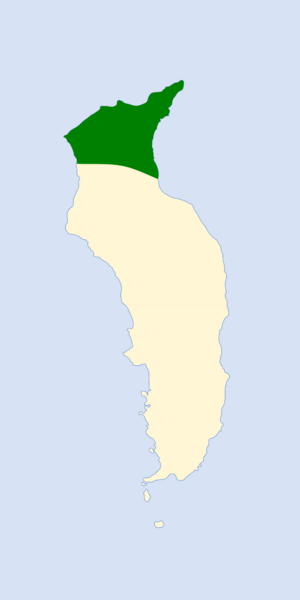Guadalupe junco facts for kids
Quick facts for kids Guadalupe junco |
|
|---|---|
 |
|
| Conservation status | |
| Scientific classification | |
| Genus: |
Junco
|
| Species: |
insularis
|
 |
|
| Synonyms | |
|
Junco hyemalis insularis Ridgway, 1876 |
|
The Guadalupe junco (Junco insularis) is a small bird. It lives only on Guadalupe Island, off the coast of Baja California, Mexico. This means it is endemic to that island, found nowhere else in the world! It belongs to the New World sparrow family.
For a while, scientists thought it was a type of another bird, the dark-eyed junco. But in 2016, they decided it was its own unique species.
Contents
What Does the Guadalupe Junco Look Like?
The Guadalupe junco has a dull grayish head and a gray beak. Its back is brownish. Its wings and tail are dark, but the tail has white edges. Its belly is white, with a reddish-brown color under its wings.
This bird makes a high, sharp sik sound. It also sings a long series of chipping notes.
Where Do They Live?
Today, these birds mostly live in groves of Guadalupe cypress trees. You can also find a few in the remaining Monterey pine trees on Guadalupe Island. Around the year 1900, they used almost any habitat to build their nests.
They used to roam the whole island looking for food. Now, only a few groups of these birds exist. Most of them are in the northern part of the island. Some birds even nest near the seashore in non-native tobacco plants. These plants are thick enough to offer some protection from feral cats.
Life Cycle and Reproduction
The breeding season for the Guadalupe junco is from February to June. The female bird lays three to four eggs. These eggs are greenish-white with reddish-brown spots.
The birds build a bulky cup nest using dried grass stems. They place their nests either in a dip in the ground or on the lower branches of a tree. If there is plenty of food, these birds might breed twice a year.
Why Are These Birds in Danger?
The Guadalupe junco used to be very common. But now, only about 50 to 100 adult birds are left. Most of them live in the northern part of Guadalupe Island.
The Problem with Goats and Cats
In the 1800s, domestic goats were brought to the island. They were meant to provide food for people. But these goats became feral, meaning they lived in the wild. They multiplied very quickly and took over the island. By the 1870s, there were more than four goats for every hectare of land!
Then, domestic cats were also brought to the island. They also became feral and multiplied. As the goats destroyed the plants and trees, the cats hunted the native wildlife. In 1897, a scientist named Kaeding saw that the juncos were already decreasing because of the feral cats.
Another scientist, Anthony, noted in 1901 that the juncos were "slowly but surely becoming scarce." He believed it was because the goats destroyed their homes, and the cats hunted the birds.
Hope for the Future
In 1906, scientists found the Guadalupe junco "fairly abundant." They also noted that the birds were still "very tame" and not afraid of predators. This made them easy targets for the feral cats.
Good news came in 2006! The feral goats were removed from the island. This allowed the native plants to grow back wonderfully. The island is now a protected area called a biosphere reserve.
If the feral cats can be controlled or removed, the remaining Guadalupe juncos will find safer places to live and breed. The future for the Guadalupe junco looks brighter now than it did in the 1900s. However, they are still very close to extinction. A big storm or a new disease could still wipe them out. Because of this, they are listed as Endangered on the IUCN Red List.


